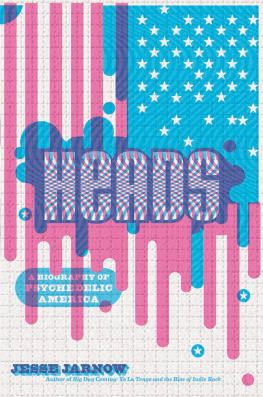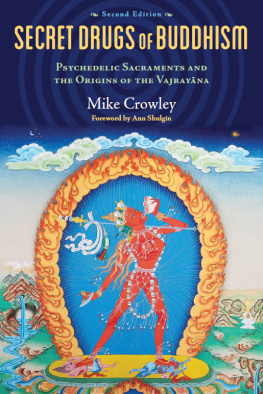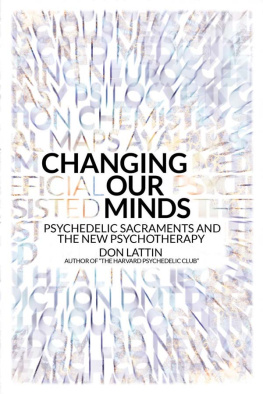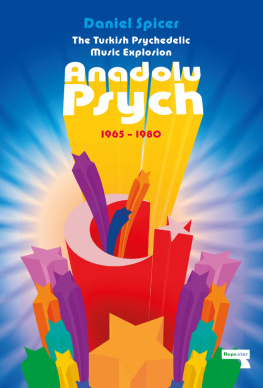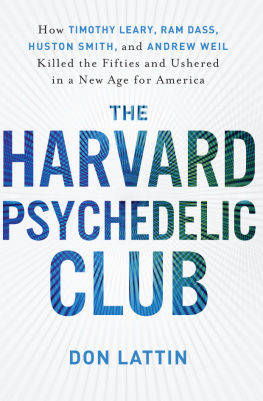Jarnow - Heads: A Biography of Psychedelic America
Here you can read online Jarnow - Heads: A Biography of Psychedelic America full text of the book (entire story) in english for free. Download pdf and epub, get meaning, cover and reviews about this ebook. year: 2016, publisher: Da Capo Press, genre: Detective and thriller. Description of the work, (preface) as well as reviews are available. Best literature library LitArk.com created for fans of good reading and offers a wide selection of genres:
Romance novel
Science fiction
Adventure
Detective
Science
History
Home and family
Prose
Art
Politics
Computer
Non-fiction
Religion
Business
Children
Humor
Choose a favorite category and find really read worthwhile books. Enjoy immersion in the world of imagination, feel the emotions of the characters or learn something new for yourself, make an fascinating discovery.
- Book:Heads: A Biography of Psychedelic America
- Author:
- Publisher:Da Capo Press
- Genre:
- Year:2016
- Rating:4 / 5
- Favourites:Add to favourites
- Your mark:
- 80
- 1
- 2
- 3
- 4
- 5
Heads: A Biography of Psychedelic America: summary, description and annotation
We offer to read an annotation, description, summary or preface (depends on what the author of the book "Heads: A Biography of Psychedelic America" wrote himself). If you haven't found the necessary information about the book — write in the comments, we will try to find it.
A sweeping, freewheeling, enlightening, and madly entertaining history of psychedelic drugs and their considerable and continuing cultural influence on America.
Jarnow: author's other books
Who wrote Heads: A Biography of Psychedelic America? Find out the surname, the name of the author of the book and a list of all author's works by series.
Heads: A Biography of Psychedelic America — read online for free the complete book (whole text) full work
Below is the text of the book, divided by pages. System saving the place of the last page read, allows you to conveniently read the book "Heads: A Biography of Psychedelic America" online for free, without having to search again every time where you left off. Put a bookmark, and you can go to the page where you finished reading at any time.
Font size:
Interval:
Bookmark:
First: my love, Caitlin.
My supportive family, both present and not: Al Jarnow, Jill Stamberg Jarnow, Lois Stamberg, Mel Stamberg, Jeanette Jarnow, Al Sr., Peter Stamberg, Paul Aferiat, Bea Aboff, Ruth Stamberg, all assorted Potters, Allen Farbman, and Lizzie Crowley. And even the Lord Nose, too.
My agent, Paul Bresnick, for seeing something in this idea when it was only an overexcited trend piece. Ben Schafer at Da Capo for going for it. Carolyn Sobczak for managing edits and bibliographic meltdowns.
New York heads: Bill Stites, Ariella Stok, Matt Van Brink, Gabrielle Kerson, Mark Suppes, Jack Chester (thanks for the desk space), Chris Pascerella, Jon Sumber, Tim Holmes, Frankie Pancakes, everybody at WFMU, Dan Bodah (who found the Nancy tape), Paul Lovelace and Jessica Wolfson, Kid Millions, the Tall Firs, Yo La Tengo, Alex Holden, Aaron Benor, Dan Lynch, Jonas Blank, Billy Jones, Zach Mexico, Matt Werth.
Various heady elders, who helped open doors for years both before this book existed (or I met them) and after, including (but not limited to): Dan Levy, Richard Gehr, Steve Silberman, David Gans.
Deepest extended thanks to every interview subject, most especially those who had never been interviewed before.
Nick Meriwether at the Grateful Dead Archive in Santa Cruz for genuine Southern academic hospitality and countless perspectives, as important to the archive as the collection itself. Rebecca Adams, the mother of Deadhead studies. The proprietors of the wondrous Dead historical blogs for endless help with source checking and suggestions of new paths: Corry Arnold (who introduced me to Humbeads Map), Caleb Kennedy, and Joe Jupille. Barry Barnes, Jake Cohen, Peter Richardson, Kaye Robin Alexander, Mel Backstrom, Sarah Moser, and every member of the annual Grateful Dead Scholars Caucus.
For heroic feats in transcription and special assignment scanning: Bob Trudeau, Courtney Klossner.
For thoughtful new directions in miscellaneous research: Mark McCloud, Tim Scully, Sean Howe, Tyler Wilcox, Rob Mitchum, Michaelangelo Matos, Chris Elcock, Fred Turner, Jade Dellinger, Rex Weiner, Ben Zimmer.
For tolerating miscellaneous queries: Lorren Daro, Wavy Gravy, Gilbert Shelton, Eric Thompson.
Editors of all stripes that abetted this project directly or indirectly: Maura Johnston, Judy Berman, Jillian Mapes, Chris Weingarten, Mike Greenhaus, Michael Calore, Dean Budnick, Josh Baron, Russell Kahn, J. Edward Keyes, Andrew Male, Chuck Squatriglia, Hank Shteamer, Jessica Hopper.
Mostly convincing professionals: Pete Shapiro, Amir Bar-Lev, David Lemeiux, Doran Tyson and Ivette Ramos at Rhino Records, Benjy Eisen, Jen Bernstein, Jay Blakesberg, Julia Gruen at the Keith Haring Foundation, Robert Ward.
Unrepentant and supportive Dead freaks: Blair Jackson, Gary Lambert, Eric Schwartz, Eric Taylor, Barry Barnes, Michael Parrish, Barry Smolin.
Hosts, comrades, and helpful associates: Christian Crumlish, Owen Poindexter, Rachel Terp, Andrew Fisher, Erica Lam, Allison Feinstein, Reid Spice, David Van Brink, Tory Ervin, Lisa Jane Persky, Andy Zax, Shannon Forney, Jen Strauss, Mike Rosenthal, Dave Mandl, Dominic Umile, Peter Crosman, Richard B. Simon, Tony Weiss, Michael Slaboch, Akron/Family, M. Geddes Gengras, Greg Davis, Ellie Sanders, Spacefuzz, Tom Ceraulo, Chris Harriott, @ThoughtsOnGD, Dominic Devito, Blanca Myers, the Baby, and the spirit of Hairy Mendoza.
And last: Caitlin, my love.
T he cafe is identified by the monkeys in the window and the metal shape wrapped in tin foil dangling over the Manhattan side street. People around the East Village call the place the Dollar Sign. Peter Stampfel hears that sometimes the monkeys can be seen fucking in their cage, though he never verifies this. One day in late 1959, however, the young folk musician goes inside to determine the truthfulness of the sign advertising peyote for sale.
The hallucinogenic cactus has been around the Village for a few years, though not exactly available. The cool thing to do when I got to New York was to take peyote and go see [the Brazilian film] Black Orpheus, remembers Stampfel, then a fresh-faced twenty-one-year-old transplant from Wisconsin. Hed heard about the visionary plant from a classmate and soon read Allen Ginsbergs epic poem Howl, written partially under the influence of peyote few years earlier. But Peter Stampfel had never been able to get any for himself. It is for this reason that both he and the Dollar Signs owner are pioneers, exemplars of two new kinds of humans: a modern psychedelic drug buyer and a modern psychedelic drug dealer. The advertised goods arent illegal, but, for the first time, they are on the loose.
Inside the cafe, Stampfel would believe the story about the monkeys. The proprietor is a large man, burly and bearded. Despite the fact that its November, the man is also barefoot. Stampfel remembers Barron Bruchlos as a psychotic, crazed Ayn Rand guy. Hence the tin foilwrapped dollar sign. The owner splits a pay phone outside into three separate extensions, two for his adjacent cafes on East Sixth Street and one to his nearby basement apartment. The twenty-seven-year-old Bruchlosa Harvard man, actuallyis a true entrepreneur and right at home in Manhattans East Village, a neighborhood of freethinkers. The poet Allen Ginsbergs place, a perpetual node on several dozen underground networks, is a few blocks away.
The hallucinogenic cactus peyote had surfaced several times in the Village since the turn of the twentieth century, usually leaving its mark in the form of one or two chaotic but isolated bohemian parties. After the gang at the San Remo bar discovered they could order it cash on delivery from a pair of companies in Laredo, Texas, it circulated semiwidely throughout the neighborhood. A legendary all-night Halloween bash ensued. It was through the San Remo crowd that Allen Ginsberg had turned on before writing Howl. And this is how the Dollar Signs Barron Bruchlos gets his peyote, too, mail ordering from Laredo, grinding it up, and repackaging it for sale like the enterprising fellow he is.
From Bruchlos, Peter Stampfel purchases a bundle of the molasses-colored double-O capsulesone peyote button per capbrings them home, and splits them with his roommate. They hang out for a while and eventually Stampfel lies down. I hadnt really closed my eyes up to this point, he says. Then he does.
The closed-eye hallucinations were the most beautiful shit Id ever seen in my life. I was very fixated on the combination of blue and green, and had a long period of blue and green interactions which were of an awesome, devastating, constantly changing beauty. At a point it changed to purple and orange in a combination that Id never really considered. It made all the great art Id seen in my life seem second rate.
One part of Stampfels experience is very new; another is very, very old. Peyote and its plant relatives have been in active use in North America for millennia, most recently in northeastern Mexico and the Trans-Pecos area of Texas by groups with well-established practices. Though the westward spread of European occupiers has done much to suppress indigenous settlers, a network of Native American peyote groups thrives. Across the Rio Grande, the Mexican town of Nuevo Laredo sustains itself predominantly on its income from peyote sales, partly mail order but mostly to branches of the Native American Church. Westerners have consumed it on occasion for centuries, including Civil War prisoners who distilled it into a drink in lieu of whiskey, as well in numerous patent medicines, but none reacted the way Peter Stampfel and his friends do.
The British physiologist W. E. Dixons 1899 account of his own unguided mescal journey, however, meshes perfectly what happens to Peter Stampfel in his East Village apartment sixty years later: After sitting with closed eyes subjectively examining the color visions, on suddenly opening them for a brief space one seems to be a different self, as on waking from a dream we pass into a different world from that in which we have been.
Next pageFont size:
Interval:
Bookmark:
Similar books «Heads: A Biography of Psychedelic America»
Look at similar books to Heads: A Biography of Psychedelic America. We have selected literature similar in name and meaning in the hope of providing readers with more options to find new, interesting, not yet read works.
Discussion, reviews of the book Heads: A Biography of Psychedelic America and just readers' own opinions. Leave your comments, write what you think about the work, its meaning or the main characters. Specify what exactly you liked and what you didn't like, and why you think so.

